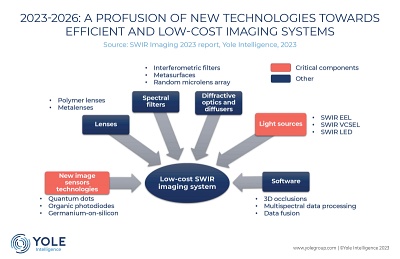From optics.org news: https://optics.org/news/14/4/15
12 Apr 2023
Yole Intelligence says that the war in Ukraine and tensions over Taiwan will push defense applications beyond prior expectations.
Analysts at France-based Yole Intelligence say the current niche market for short-wave infrared (SWIR) imaging technology will grow rapidly over the next five years, and will be worth $2.9 billion by 2028.
In a new report on the segment, which is currently dominated by applications in defense, research, and industry, Yole’s Alex Clouet suggests that SWIR technology could begin replacing near-infrared (NIR) imagers in high-end smart phones, where the technology is used for secure identification.
Together with higher growth than previously expected in the military arena, plus innovation in key component materials expected to reduce costs, the upshot is expected to be a compound annual growth rate in excess of 40 per cent over the next few years.
Although definitions of SWIR and NIR spectral ranges differ, the term SWIR is often used to refer to wavelengths between 1400 nm and 3000 nm, whereas NIR relates to the 780-1400 nm band.
According to the report, the SWIR imaging market was worth just over $300 million last year, with defense, aerospace, and research applications accounting for more than two-thirds of that total.
“The defense segment will experience higher growth than previously expected, reaching $405 million in 2028 from $228 million in 2022, pulled by geopolitical tensions such as the Ukraine war and tensions around Taiwan and an increasing number of countries becoming interested in SWIR technologies,” Yole says.
The current focus means that defense-oriented players such as Israel’s SCD, Sensors Unlimited, and Teledyne FLIR dominate the scene. But as the technology begins to find use in a larger number of industrial and consumer applications, that is likely to change.
“Many smaller players have significant growth potential, like Sony, or companies making quantum-dot-based cameras, such as SWIR Vision Systems and Emberion, which have a price advantage on high-resolution and extended spectral range products,” Yole stated.
“Newcomers bring new disruptive technologies, like STMicroelectronics, TriEye, or Artilux, to address consumer or automotive markets.”
Emberion, which is a spin-out from Nokia with facilities in Cambridge, UK, uses both colloidal quantum dots and graphene in its devices - claiming improvements in signal-to-noise, breadth of spectral response, and operating temperature.
“Traditional CMOS image sensor suppliers can be game-changers due to their high-volume production capacity and unique design and integration know-how,” observes Yole.
“However, among them, only Sony and STMicroelectronics have already developed SWIR imaging technology - even though others may show signs of interest, such as Samsung and OmniVision.
“The SWIR ecosystem waits for greater interest from these players to accelerate technological and market disruption.”
Material innovation
Nevertheless, the technology is expected to make an impact in consumer goods, with Yole’s figures suggesting the emergence of a significant consumer market over the next five years.
“In 2026, SWIR can start replacing NIR imagers in flagship smart phones for under-display integration of facial recognition modules,” reckons Clouet, adding that the resulting market for complete 3D-sensing modules will just surpass $2 billion by 2028.
Beyond that - and depending on the level of innovation and cost reductions in key components - the technology might end up being integrated into lower-end smart phones and augmented and virtual reality (AR/VR) headsets to improve the performance of tracking cameras, 3D sensing, and outdoor multispectral imaging.
Clouet also sees applications emerging in the automotive sector, where SWIR could provide enhanced vision in low light and adverse weather conditions, as well as 3D sensing capability - although this market would still be in its infancy by 2028.
Among the technological innovations that may lead to more efficient and lower-cost imaging systems, Yole highlights the potential of quantum dots, organic photodiodes, and the germanium-on-silicon material system as some potentially key developments in sensors.
At the optical component level, polymer and metasurface lenses, diffractive optics and optical diffusers, and spectral filters could also contribute to lower costs.
Yole's report, SWIR Imaging 2023, is available now via the company’s web site.


yawn
ReplyDelete